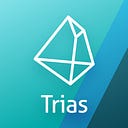1 Will the total supply of TRIAS increase?
No.
2 When will the TRIAS burn-and-swap mechanism be implemented?
We are currently working on getting eco-projects listed. We will launch ReSA accordingly to allow TRIAS holders to exchange for eco-tokens. According to the rules of ReSA, a part of TRIAS exchanged back will be burnt, and the whole process will be carried out on the chain. Everyone can check at any time.
3 When will Trias’ mainnet come online?
Trias’s mainnet is the integration of our eco-projects. In each version, it integrates a new eco-project’s testnet. Its next release will incorporate Leviatom.
By the end of Q2, we will first launch Leviatom’s testnet, and by the end of this year, I believe we will see the Trias’s new mainnet integrating Leviatom and Tusima and having Triathon as the test-driven launchpad for its Layer 1 and Layer 2 dApps.
We have completed the final testing of Leviatom’s testnet, which is a dual-chain structure containing ledgers from Layer ‘-1’ and Layer 1. We are currently in the final stage of polishing Leviatom’s website and white paper.
4 Will a developer toolkit be released to allow developers to build on Trias?
Leviatom will be a decentralized cloud computing infrastructure, specifically, a decentralized Service Mesh infrastructure hosting a decentralized FaaS (Function-as-a-Service) platform. It is designed to host any Docker image in a decentralized and consensus-oriented way, allowing Web2 developers to release and deploy their web apps as Docker images directly on it. These Docker images will then seamlessly communicate with Leviatom’s native EVM-compatible Layer 1 network to implement the ultimate off-chain computing scaling for EVMs.
Simply put, the ultimate goal of Leviatom is to let any Web2 developer write web apps and work with EVM-compatible chains directly through Leviatom. And it will be Divina’s job to help developers to compose new Leviatom-compatible Docker images from Web2 applications’ source codes.
Divina is a decentralized infrastructure for building software components from their source codes and packaging the executables into Docker images. This decentralized infrastructure will ensure the correctness of software building and Docker image packaging, so malicious codes cannot be injected along the processes. Moreover, a distributed ledger for recording the entire building and packaging life cycle will be maintained by the miners, so everyone will be able to trace any Docker image to its original source codes. This will be a significant step in the entire software engineering industry, as it fundamentally changes how developers’ proof-of-contributions are determined and how the impacts of bugs and malicious codes are identified.
We have now had a running prototype of Divina. In fact, Triathon and Tusima have already been using the prototype for building and packaging. The official release of Divina will come after Leviatom’s, as we first need an infrastructure to run Docker images and then another for creating them.
5 When will the new Trias website be released?
We are currently focusing on improving the Leviatom network, so the update of the Trias website has encountered some delays. But we still plan to finish the update by the end of Q2. Apart from the website, we are also preparing the white paper for the whole Trias ecosystem, which will introduce how all the eco-projects work together to form a chain-native technology stack. Meanwhile, we are creating promotional materials, including videos that illustrate our new ideology.
6 Where can we find real-world application cases of Trias technology?
Our technology has been applied in many scenarios in China. For more details, you can visit OCTA’s website, which was just updated. However, its English version is expected in 1–2 weeks. Google Translate can help you navigate for the moment. You’ll find news on products, technologies, use cases, and project progress.
In addition, we are also working hard to promote technology implementation in Japan. Significant cooperation with some partners has entered the final stage. We expect to have some big and exciting news that can finally be released by the end of Q2 or the beginning of Q3.
7 Are there any updates about Japanese stablecoin cooperation?
We are preparing the 3rd version of the testnet, which will run independently in Japan. The 3rd version will adapt to local application scenarios in Japan. Many of the latest technologies will be applied to improve the performance and security of the testnet.
We are also developing the Tusima wallet. In the following testnet iterations, the wallet will also be connected to the local bank card and national identity information for users in Japan. In doing this, we will test Tusima in multiple offline spending scenarios for Japanese users.
Our CSO Mr. Shin Sai is going to do an AMA soon, sharing our strategies and roadmap for developing the Japanese market. We will let you know in advance.
8 Updates about the Triathon liquidity pools being silent since February.
After injecting the essential liquidity, the pool is temporarily in the primary stage to meet the liquidity needs of individual users. We will consider adjusting the liquidity when the market meets expectations.
In response to community feedback, we have designed a staking reward mechanism for users willing to provide liquidity. The new mechanism will enter the testing phase soon and is expected to be released to the community by the end of April.
Read Trias AMA since July 2022
Trias AMA_Feb 2023 | Trias AMA_Jan 2023 | Trias AMA_Dec 2022 | Trias AMA_Nov 2022 | Trias AMA_Oct 2022 | Trias AMA_Sept 2022 | Trias AMA_Aug 2022 | Trias AMA_Jul 2022
Ten questions were answered for March. Check the table below. Winners will be announced next week.
Official website: https://www.trias.one
Whitepaper: https://www.trias.one/whitepaper
Telegram: https://t.me/triaslab
Twitter: https://twitter.com/triaslab
Discord: https://discord.gg/uSHpezwKWZ
Notion: https://www.notion.so/Trias-62b0088a57a74c62b22099206464426d
Trade on Pancake: https://triaslab.medium.com/how-to-buy-trias-on-pancakeswap-d9bd1628e69f
